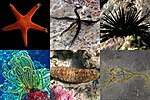Echinoderm (redirect from Phylum echinodermata)
(/ɪˈkaɪnəˌdɜːrm, ˈɛkə-/) is any deuterostomal animal of the phylum Echinodermata (/ɪˌkaɪnoʊˈdɜːrmətə/), which includes starfish, brittle stars, sea urchins...
77 KB (8,537 words) - 16:19, 6 June 2024
largest crinoid order, Comatulida. Crinoids are echinoderms in the phylum Echinodermata, which also includes the starfish, brittle stars, sea urchins and sea...
43 KB (4,559 words) - 13:20, 9 June 2024
Peripodida) make up an unusual group of deep-sea taxa belonging to the phylum Echinodermata, with three species described in the genus Xyloplax. Intestine and anus...
2 KB (199 words) - 18:17, 15 December 2023
Protozoa, Porifera, Coelenterata, Platyhelminthes, Nematoda, Annelida, Echinodermata, Mollusca and Arthropoda. Arthropoda include insects, crustaceans and...
43 KB (4,816 words) - 03:26, 7 June 2024
PMC 2695056. PMID 19470464. Wagonner, Ben (1994). "Echinodermata: Fossil Record". Echinodermata. The Museum of Paleontology of The University of California...
105 KB (11,388 words) - 16:52, 3 June 2024
Articulata (Crinoidea) (redirect from Articulata (Echinodermata))
(2017-02-22). "Phylogenetic taxonomy and classification of the Crinoidea (Echinodermata)". Journal of Paleontology. 91 (4): 829–846. doi:10.1017/jpa.2016.142...
6 KB (653 words) - 03:12, 19 July 2023
Tafraout Group (section Echinodermata)
The Tafraout Group (Also "Tafraoute Group" or Zaouiat Ahançal Group) is a geological group of formations of Toarcian-Aalenian (Lower Jurassic-Middle Jurassic)...
127 KB (9,839 words) - 15:05, 5 June 2024
List of echinoderm orders (redirect from List of echinodermata orders)
species as well as the extinct species of the exclusively marine phylum Echinodermata. Subclass Articulata (540 species) Order Bourgueticrinida Order Comatulida...
10 KB (470 words) - 21:27, 18 May 2024
development. Deuterostomia is further divided into 4 phyla: Chordata, Echinodermata, Hemichordata, and the extinct Vetulicolia known from Cambrian fossils...
33 KB (3,164 words) - 20:06, 15 May 2024
(sea cucumbers) are one of five extant classes that make up the phylum Echinodermata. This is one of the most distinctive and diverse phyla, ranging from...
60 KB (6,679 words) - 03:41, 19 May 2024
relatives of the Chordates are believed to be the Hemichordates and Echinodermata, which together form the Ambulacraria. The Chordata and Ambulacraria...
52 KB (4,756 words) - 23:47, 5 June 2024
The largest animal currently alive is the blue whale. The maximum recorded weight was 190 tonnes for a specimen measuring 27.6 metres (91 ft), whereas...
162 KB (16,228 words) - 12:59, 9 June 2024
List of troglobites (section Echinodermata)
A troglobite (or, formally, troglobiont) is an animal species, or population of a species, strictly bound to underground habitats, such as caves. These...
17 KB (1,548 words) - 14:11, 4 June 2024
Antarctic feather star species complex Promachocrinus 'kerguelensis' (Echinodermata: Crinoidea)". Invertebrate Systematics. 37 (7): 498–527. doi:10.1071/IS22057...
3 KB (304 words) - 17:55, 7 December 2023
through invagination of the endoderm. The main deuterostome phyla are the Echinodermata and the Chordata. Echinoderms are exclusively marine and include starfish...
125 KB (11,182 words) - 08:37, 6 June 2024
been used as protective amulets. Sea urchins are members of the phylum Echinodermata, which also includes sea stars, sea cucumbers, sand dollars, brittle...
74 KB (7,699 words) - 19:33, 9 June 2024
List of animal classes (section Echinodermata (starfish, sea urchins, sand dollars, sea lilies, and others))
The following is a list of the classes in each phylum of the kingdom Animalia. There are 107 classes of animals in 33 phyla in this list. However, different...
8 KB (503 words) - 22:35, 6 June 2024
Revised. Arthropoda 4 --- in preparation). Part S. Echinodermata 1, Volumes 1 and 2: Echinodermata General Features, Homalozoa, Crinozoa (exclusive of...
30 KB (2,947 words) - 22:55, 8 June 2024
Atelecrinidae is a family of crinoids or feather stars in the phylum Echinodermata. It was first described by Francis Arthur Bather in 1899. The following...
2 KB (168 words) - 20:05, 20 December 2023
"Paedomorphosis, Aristotle's lantern, and the origin of the sand dollars (Echinodermata: Clypeasteroida)". Paleobiology. 16 (1): 25–48. Bibcode:1990Pbio...16...
15 KB (1,570 words) - 23:10, 15 April 2024
23, 2018. Miller, J. E.; Pawson, David L., Swimming Sea Cucumbers (Echinodermata: Holothuroidea): A Survey, with Analysis of Swimming Behavior in Four...
8 KB (771 words) - 17:05, 18 February 2024
Paleobiota of the Burgess Shale (section Echinodermata)
Echinodermata Genus Class Abundance Notes Images Gogia Eocrinoidea Six specimens This echinoderm was a primitive member of the eocrinoid group (which...
72 KB (1,446 words) - 18:35, 16 April 2024
Nusplingen Limestone (section Echinodermata)
The Nusplingen Limestone (German: Nusplingen Plattenkalk) is a geological formation in Baden-Württemberg, Germany. It preserves fossils dating to the Kimmeridgian...
19 KB (1,022 words) - 23:37, 15 May 2024
The smallest organisms found on Earth can be determined according to various aspects of organism size, including volume, mass, height, length, or genome...
46 KB (5,139 words) - 06:56, 19 May 2024
invertebrates: Echinodermata. McGraw-Hill Book Company Inc., New York. Jordan, A.J. 1972. On the ecology and behavior of Cucumaria frondosa (Echinodermata: Holothuroidea)...
7 KB (800 words) - 20:54, 23 August 2022
The Fauna of British India (short title) with long titles including The Fauna of British India, Including Ceylon and Burma, and The Fauna of British India...
21 KB (2,124 words) - 23:39, 30 April 2024
The Asterozoa are a subphylum in the phylum Echinodermata. Characteristics include a star-shaped body and radially divergent axes of symmetry. The subphylum...
5 KB (541 words) - 21:20, 6 May 2023
David J. (18 April 2017). "A diverse assemblage of Permian echinoids (Echinodermata, Echinoidea) and implications for character evolution in early crown...
113 KB (11,640 words) - 11:25, 13 May 2024
Windom shale (section Echinodermata)
The Windom shale or Windom member is a member of the Moscow formation in New York. It preserves fossils going back to the Givetian stage of the middle...
11 KB (1,047 words) - 03:01, 13 October 2023
visible in fossils. See also List of echinodermata orders. Reich, M., and R. Haude. "Ophiocistioidea (fossil Echinodermata): an overview." Echinoderms: München...
2 KB (214 words) - 22:37, 6 October 2021

























